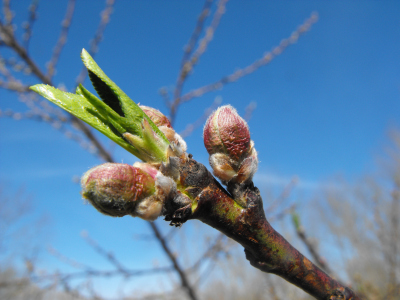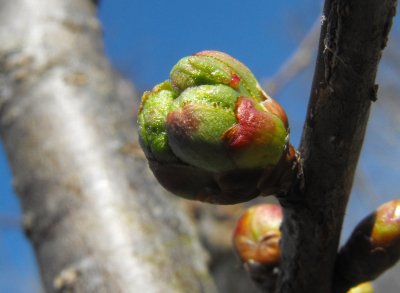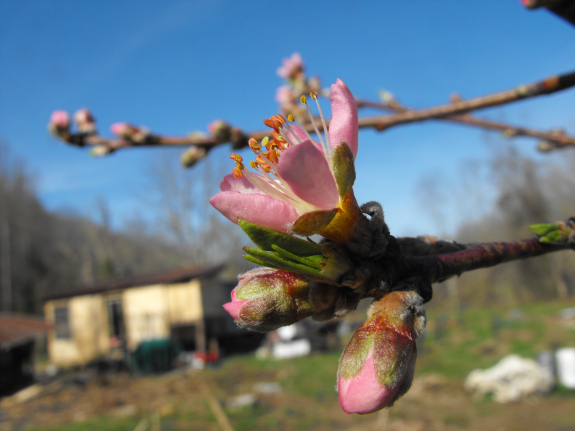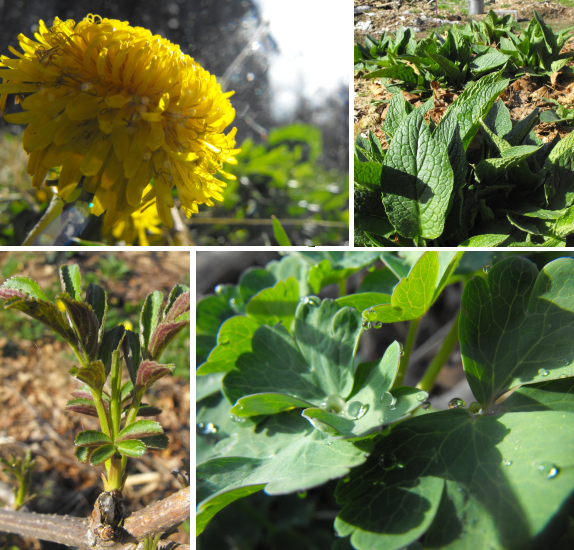
Bud break
 Plant
a fruit tree and learn patience. You'll tend them and love them
for three years, or four years, or five years before tasting the first
sampling of their fruit. But then the harvest will steadily grow,
until within a decade you have buckets and barrels full of apples,
pears, peaches, and plums.
Plant
a fruit tree and learn patience. You'll tend them and love them
for three years, or four years, or five years before tasting the first
sampling of their fruit. But then the harvest will steadily grow,
until within a decade you have buckets and barrels full of apples,
pears, peaches, and plums.
At least that's the
dream. Our first stab at making it a reality
failed when we planted fruit trees directly into our wet clay soil and
ended up with so many dead sticks. So we planted again in 2007,
this time in raised beds, starting small as we
figured out what we'd done wrong, then adding more trees in the
following years.

It was really too early
to see any fruits last year, but profuse blooms
on our oldest peach made me hope for a harvest. Then a late
freeze wiped out every bloom, and I went back to pruning and training
and mulching with no reward.
My fruit tree
spreadsheet, though, says that this year may be
different. Peaches and dwarf cherries can fruit at three years,
and our two oldest trees are coated with bumpy flower buds. In
fact, even our two year old peach and nectarine are similarly laden,
though I refuse to get my hopes up about premature fruit this year.
I've been watching the
flower buds all winter with avid curiosity, and
Sunday the inevitable happened. A week of summer-like
temperatures tempted peaches to go from green bud to red bud stage (top
picture), while the cherry buds actually burst open (second picture),
revealing the individual flower buds within. Finally, I reached
the nectarine, planted in the sunniest spot against the side of the
barn. I saw a hint of brilliant pink in one bud and just kept
photographing my way around the tree until...

...a fully opened bloom!
I can't resist throwing
in a few more shots of the signs of spring that
have been bursting out in the garden this week. The dandelions
are now in full bloom, and the comfrey (top right) has leaves bigger
than my hand, ready to take back their job of mulching
the nectarine.
Elderberry leaves (bottom left) have been growing slowly for weeks ---
these seem to be the first spring tree leaves on the farm.
Finally, the columbine has really caught hold and looks to
have bloom buds on the way. Spring!

Want more in-depth information? Browse through our books.
Or explore more posts by date or by subject.
About us: Anna Hess and Mark Hamilton spent over a decade living self-sufficiently in the mountains of Virginia before moving north to start over from scratch in the foothills of Ohio. They've experimented with permaculture, no-till gardening, trailersteading, home-based microbusinesses and much more, writing about their adventures in both blogs and books.
Want to be notified when new comments are posted on this page? Click on the RSS button after you add a comment to subscribe to the comment feed, or simply check the box beside "email replies to me" while writing your comment.
